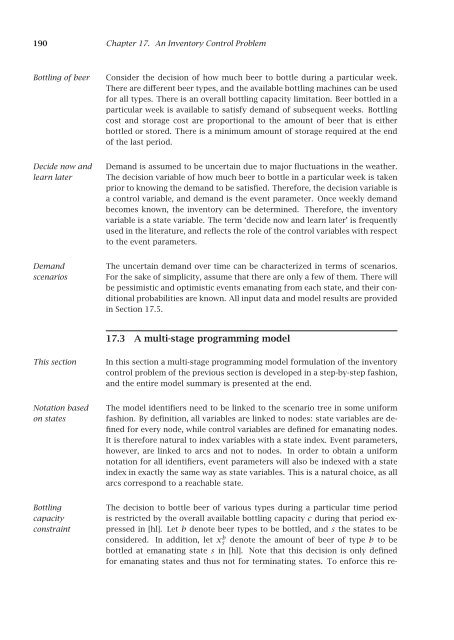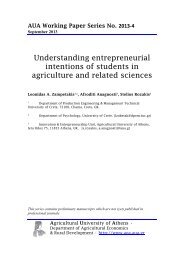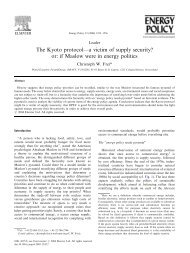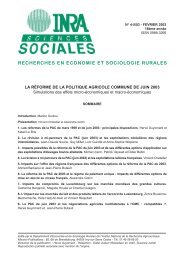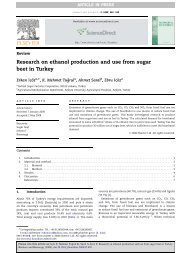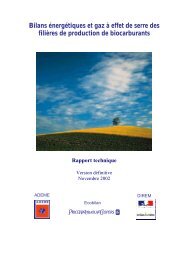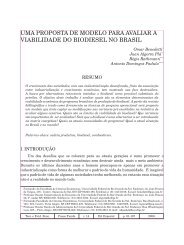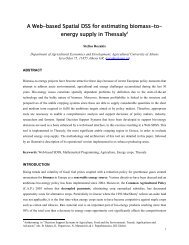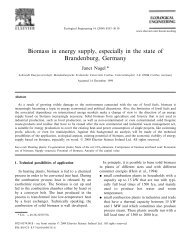Optimization Modeling
Optimization Modeling
Optimization Modeling
Create successful ePaper yourself
Turn your PDF publications into a flip-book with our unique Google optimized e-Paper software.
190 Chapter 17. An Inventory Control Problem<br />
Bottling of beer<br />
Consider the decision of how much beer to bottle during a particular week.<br />
There are different beer types, and the available bottling machines can be used<br />
for all types. There is an overall bottling capacity limitation. Beer bottled in a<br />
particular week is available to satisfy demand of subsequent weeks. Bottling<br />
cost and storage cost are proportional to the amount of beer that is either<br />
bottled or stored. There is a minimum amount of storage required at the end<br />
of the last period.<br />
Decide now and<br />
learn later<br />
Demand is assumed to be uncertain due to major fluctuations in the weather.<br />
The decision variable of how much beer to bottle in a particular week is taken<br />
prior to knowing the demand to be satisfied. Therefore, the decision variable is<br />
a control variable, and demand is the event parameter. Once weekly demand<br />
becomes known, the inventory can be determined. Therefore, the inventory<br />
variable is a state variable. The term ‘decide now and learn later’ is frequently<br />
used in the literature, and reflects the role of the control variables with respect<br />
to the event parameters.<br />
Demand<br />
scenarios<br />
The uncertain demand over time can be characterized in terms of scenarios.<br />
For the sake of simplicity, assume that there are only a few of them. There will<br />
be pessimistic and optimistic events emanating from each state, and their conditional<br />
probabilities are known. All input data and model results are provided<br />
in Section 17.5.<br />
17.3 A multi-stage programming model<br />
This section<br />
In this section a multi-stage programming model formulation of the inventory<br />
control problem of the previous section is developed in a step-by-step fashion,<br />
and the entire model summary is presented at the end.<br />
Notation based<br />
on states<br />
The model identifiers need to be linked to the scenario tree in some uniform<br />
fashion. By definition, all variables are linked to nodes: state variables are defined<br />
for every node, while control variables are defined for emanating nodes.<br />
It is therefore natural to index variables with a state index. Event parameters,<br />
however, are linked to arcs and not to nodes. In order to obtain a uniform<br />
notation for all identifiers, event parameters will also be indexed with a state<br />
index in exactly the same way as state variables. This is a natural choice, as all<br />
arcs correspond to a reachable state.<br />
Bottling<br />
capacity<br />
constraint<br />
The decision to bottle beer of various types during a particular time period<br />
is restricted by the overall available bottling capacity c during that period expressed<br />
in [hl]. Let b denote beer types to be bottled, and s the states to be<br />
considered. In addition, let x b s denote the amount of beer of type b to be<br />
bottled at emanating state s in [hl]. Note that this decision is only defined<br />
for emanating states and thus not for terminating states. To enforce this re-


